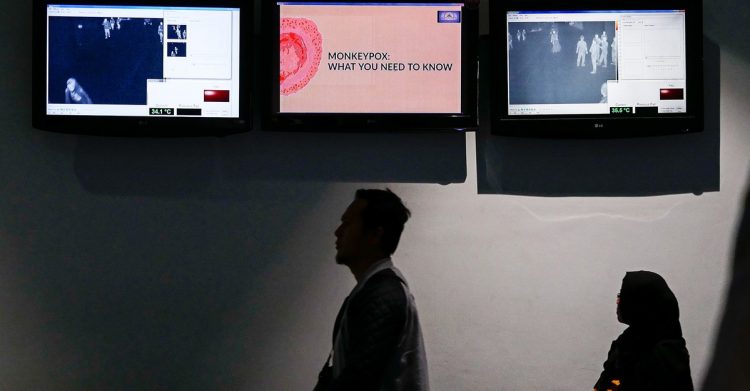The first reports of monkeypox cases in Europe began to surface in mid-May. A week later, there were 92 confirmed cases outside the Central and West African countries where the disease usually circulates; now there are 1,200. By the end of this month, who knows? “If you’d asked me two weeks ago, I would have anticipated that there might be a few thousand cases globally related to this current outbreak” before it ended, Jay Varma, a population-health professor at Weill Cornell Medical College, told me. “But I’ve become much more pessimistic.”
Where, exactly, is the outbreak headed? When I asked five experts for their predictions, they would say only one thing for certain: Monkeypox is not the next COVID-19. It’s simply not transmissible enough to cause infections on the scale of the pandemic, nor does it seem to be a particularly deadly virus. (None of the 1,200 patients has died so far.) But beyond that, their views ranged widely: The outbreak may be over before we know it; or it might become a modest, intermittent problem; or it could transform into an ever-present risk and inconvenience, like the next genital herpes. Here are three possible paths monkeypox could take.
The Rosy Scenario: A Quick Fizzle
This is not the first time monkeypox has entered the United States. At least 47 people in six states fell ill from the virus in 2003 after interacting with infected pet prairie dogs (legal to own in most states!). The spread was contained within a couple of months, and nobody died; two people got seriously sick, but they recovered.
This time around, prairie dogs are not involved. Most, if not all, of this year’s monkeypox cases in the U.S. appear to have resulted from person-to-person contact. That makes the public-health response more complicated than euthanizing potentially infected animals, as officials did in 2003. We might still quash the spread quickly through immunization, Amesh Adalja, a senior scholar at the Johns Hopkins Center for Health Security, told me. After all, the U.S. has a stockpile of smallpox vaccines on hand that would also work against this outbreak. (The exact size of the stockpile remains unclear.) “Monkeypox is a containable virus,” he told me.
The 2003 outbreak was brought to heel, in part, through a tactic called ring vaccination, in which the close contacts of an infected patient are all inoculated. This works because contact tracing for monkeypox is relatively easy thanks to the physical proximity necessary for its transmission, and because vaccinating someone who has recently been infected can keep them from becoming contagious. Adalja predicts that ring vaccination will likely outpace the spread of monkeypox in the U.S. in a matter of weeks, and that cases will fall to zero within about three months.
The Medium Scenario: A Sporadic Problem
Monkeypox already breaks out from time to time in Central and West Africa. Experts say that’s because the virus is endemic in local animal populations, probably some kind of mammal. The same could happen here in the U.S.: If enough American wildlife get infected through interactions with infected humans, then monkeypox could circulate in silence after human cases drop to zero. Every so often, an animal would infect a person, that person would spread the virus to some close contacts, and another minor outbreak would form, then fizzle out. Repeat indefinitely.
Bhargavi Rao, who worked in the Democratic Republic of Congo and the Central African Republic as the head of emerging and infectious diseases at Doctors Without Borders, told me that a spate of monkeypox infections is “not the sort of thing that overwhelms a community.” She said she thinks the risk of monkeypox becoming endemic in animals outside Central and West Africa is “very low,” but if it did, its effects would be akin to those of modern anthrax, rabies, or bird flu; that is, it might cause occasional disruption and lead to occasional culling of animals, but it wouldn’t generally affect daily life. (James Diaz, the director of environmental and occupational health at Louisiana State University, told me that he suspects monkeypox might already be endemic in American wildlife—but also that there’s no hard evidence to support this claim.)
The fact that many recent cases have been recorded in and around big cities could lead to different outcomes, though. In the countries where Rao worked, the disease mostly jumps from wildlife to farmers and bush hunters who live in isolated communities. She said there’s no way of knowing how big an outbreak might get in an American metropolis, even as those at risk would generally have better access to testing and vaccines. If the outbreak were big enough, the virus might become endemic in rodent populations, causing further urban outbreaks down the line. “When it’s in the rats, there’s nothing you can do,” Adalja told me.
The Bad Scenario: Another Syphilis
We’ll be dealing with something entirely different if the current outbreak can’t be stopped. Both Rao and Adalja said such an outcome seems unlikely because monkeypox patients are generally not infectious before they’re symptomatic, and the world already has tests, vaccines, and treatments for the virus. But the conventional wisdom about monkeypox might not hold for this outbreak. Varma, who helped lead New York City’s response to COVID, is much more worried than the other experts I spoke with. “I would say it’s less than 50 percent probability that we will contain this,” he said.
That’s not to say that one-third of the country is likely to come down with monkeypox in the next six months. Varma predicts that monkeypox will continue to circulate at low levels and stay concentrated in the community of men who have sex with men. (To be clear, monkeypox is not a sexually transmitted infection. The CDC has said that “a high number” of cases so far have involved men who have sex with men, but the disease can be spread through sexual or nonsexual contact between anyone.) If that’s what happens, then monkeypox would be similar to syphilis, Varma said, which affects about 0.04 percent of Americans, most of them men who have sex with men. In Varma’s absolute worst-case scenario—which he thinks is less likely—monkeypox could spread through all sorts of communities, including children and pregnant women, and become as common as genital herpes, with more than 12 percent of Americans infected.
Again, this would not spell civilizational collapse. Very few people who contract monkeypox die from it or get seriously sick. Even if monkeypox did become widespread among the American population, Adalja told me, routine vaccination could eliminate much of the associated risks to people’s health. But the more people who get sick, the greater the likelihood that someone will experience a rare and serious complication. Population-scale vaccination, too, could have some downsides.
We also don’t know how the disease will change. DNA viruses, including monkeypox, are generally stable, and evolve into new strains slowly. But “it’s never a good thing to let a zoonotic virus spread unchecked in humans,” Boghuma Titanji, an infectious-disease specialist at Emory University, told me. “The reality is you do not know what the adaptation of that virus in a new host will do.” It could become more or less transmissible, more or less capable of causing serious disease and death. Or it could stay pretty much the same.
No one will be able to accurately forecast the future of this outbreak until we’re certain of the present. And we’re just not there yet. The virus’s incubation period averages one to two weeks, but can stretch as long as three, which means the cases we’re seeing now reflect the spread of the virus many days ago. We’re also not testing enough to keep track of the outbreak, Titanji told me.
Testing is especially important because cases in the current outbreak look so different from classical monkeypox. Historically, monkeypox lesions developed around the tongue and mouth first, followed by a rash on the face, arms, and legs, which progressed into lesions; those symptoms were easy to see. The recent outbreak, however, has included many patients who have only a handful of lesions, concentrated around their genitalia and anus. In the past, U.S. cases of monkeypox were travel-related, and people who fell ill showed up to travel clinics or told their doctor they’d been out of the country; now patients might show up at sexual-health clinics to investigate the scabs on their private parts. The more accessible testing is, the easier it will be for patients to be identified and advised to isolate, while vaccines are provided to their contacts. “The sooner you can get a lab-confirmed infection, the sooner people take it seriously,” Varma said.
For now, we still don’t know how many people around the country are infected, nor how many others will eventually get sick. When I asked Titanji how and when we’ll know which path we’re on, she said it’s difficult to tell, and not worth guessing. “Every time a virus crosses species and gets into a new species, and it’s transmitting itself and causing outbreaks, you are in a gray zone.”
Source by www.theatlantic.com


